ServiceNow Connector for SSRS
Allows the reading and writing of incidents, attachments, and more in ServiceNow without coding! The ZappySys ServiceNow API Connector provides easy-to-use, high-performance API access.
In this article you will learn how to quickly and efficiently integrate ServiceNow data in SSRS without coding. We will use high-performance ServiceNow Connector to easily connect to ServiceNow and then access the data inside SSRS.
Let's follow the steps below to see how we can accomplish that!
ServiceNow Connector for SSRS is based on ZappySys API Driver which is part of ODBC PowerPack. It is a collection of high-performance ODBC drivers that enable you to integrate data in SQL Server, SSIS, a programming language, or any other ODBC-compatible application. ODBC PowerPack supports various file formats, sources and destinations, including REST/SOAP API, SFTP/FTP, storage services, and plain files, to mention a few.
Video Tutorial - Integrate ServiceNow data in SSRS
This video covers the following topics and more, so please watch carefully. After watching the video, follow the steps outlined in this article:
- How to download and install the required PowerPack for
ServiceNow integration in SSRS - How to configure the connection for
ServiceNow - Features of the
ZappySys API Driver (Authentication / Query Language / Examples / Driver UI) - How to use the
ServiceNow in SSRS
Create Data Source in ZappySys Data Gateway based on API Driver
-
Download and install ODBC PowerPack.
-
Search for gateway in start menu and Open ZappySys Data Gateway:

-
Go to Users Tab to add our first Gateway user. Click Add; we will give it a name tdsuser and enter password you like to give. Check Admin option and click OK to save. We will use these details later when we create linked server:

-
Now we are ready to add a data source. Click Add, give data source a name (Copy this name somewhere, we will need it later) and then select Native - ZappySys API Driver. Finally, click OK. And it will create the Data Set for it and open the ZS driver UI.
ServicenowDSN

-
When the Configuration window appears give your data source a name if you haven't done that already, then select "ServiceNow" from the list of Popular Connectors. If "ServiceNow" is not present in the list, then click "Search Online" and download it. Then set the path to the location where you downloaded it. Finally, click Continue >> to proceed with configuring the DSN:
ServicenowDSNServiceNow
-
Now it's time to configure the Connection Manager. Select Authentication Type, e.g. Token Authentication. Then select API Base URL (in most cases, the default one is the right one). More info is available in the Authentication section.
ServiceNow authentication
Authenticate using ServiceNow instance username and password.
Locate your ServiceNow instance credentials and use them for HTTP authentication:
- Go to https://developer.servicenow.com/dev.do and log in.
- Click on your profile picture.
-
When a menu appears, click on Manage instance password or a similar option:
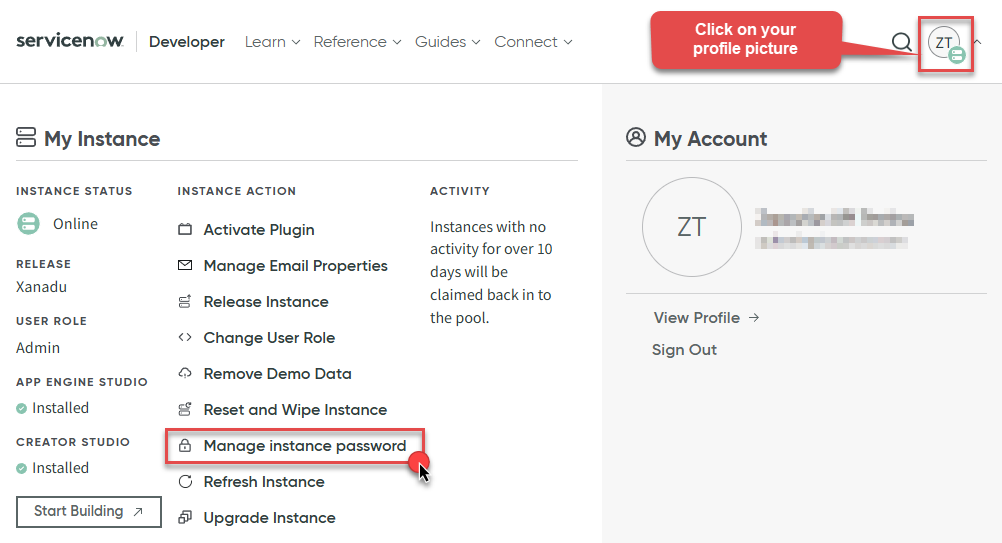
-
In a new window you will see your HTTP Basic Authentication credentials:
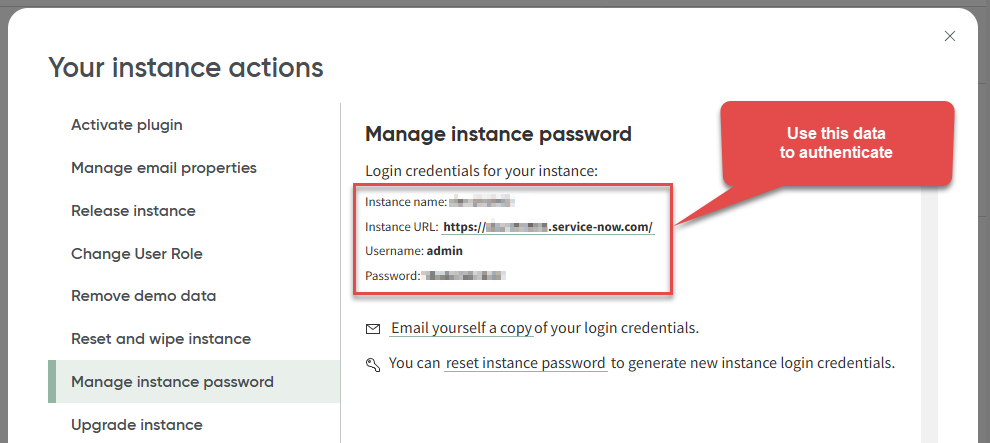
-
Done! Use this username and password when configuring OAuth Authentication parameters.
API Connection Manager configuration
Just perform these simple steps to finish authentication configuration:
-
Set Authentication Type to
Basic Auth [Http] - Optional step. Modify API Base URL if needed (in most cases default will work).
- Fill in all the required parameters and set optional parameters if needed.
- Finally, hit OK button:
ServicenowDSNServiceNowBasic Auth [Http]https://[$InstanceName$].service-now.com/api/nowRequired Parameters InstanceName Fill-in the parameter... User name Fill-in the parameter... Password Fill-in the parameter... Optional Parameters ApiVersion v2 RetryMode RetryWhenStatusCodeMatch RetryStatusCodeList 429 RetryCountMax 5 RetryMultiplyWaitTime True 
ServiceNow authentication
Authenticate using ServiceNow instance username, password, OAuth Client ID, and Client Secret. [API reference]
Create OAuth application and use it for authentication:
- Login to your instance at https://your-instance-id.service-now.com.
-
Start by clicking on menu item All, then search for oauth, and click Application Registry option:
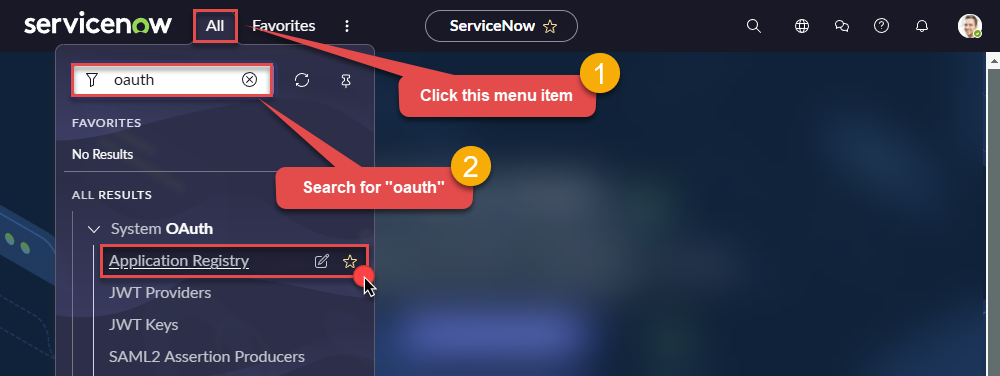
-
Then click button New:

-
Continue by clicking Create an OAuth API endpoint for external clients option:

-
Move on by naming your OAuth application and entering a Client Secret (or let it be generated automatically).
-
Finally give it a final touch by increasing the Refresh Token Lifespan value to
315,360,000(it should last for 10 years):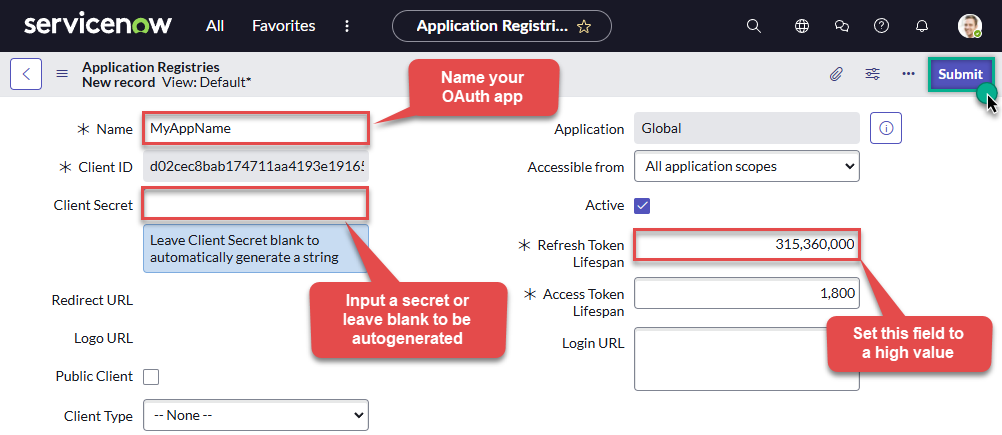
-
Done! Now you can use Client ID and Client Secret when configuring OAuth Authentication parameters.
API Connection Manager configuration
Just perform these simple steps to finish authentication configuration:
-
Set Authentication Type to
OAuth [OAuth] - Optional step. Modify API Base URL if needed (in most cases default will work).
- Fill in all the required parameters and set optional parameters if needed.
- Finally, hit OK button:
ServicenowDSNServiceNowOAuth [OAuth]https://[$InstanceName$].service-now.com/api/nowRequired Parameters InstanceName Fill-in the parameter... User name Fill-in the parameter... Password Fill-in the parameter... Client ID Fill-in the parameter... Client Secret Fill-in the parameter... ApiVersion Fill-in the parameter... Optional Parameters RetryMode RetryWhenStatusCodeMatch RetryStatusCodeList 429|503 RetryCountMax 5 RetryMultiplyWaitTime True 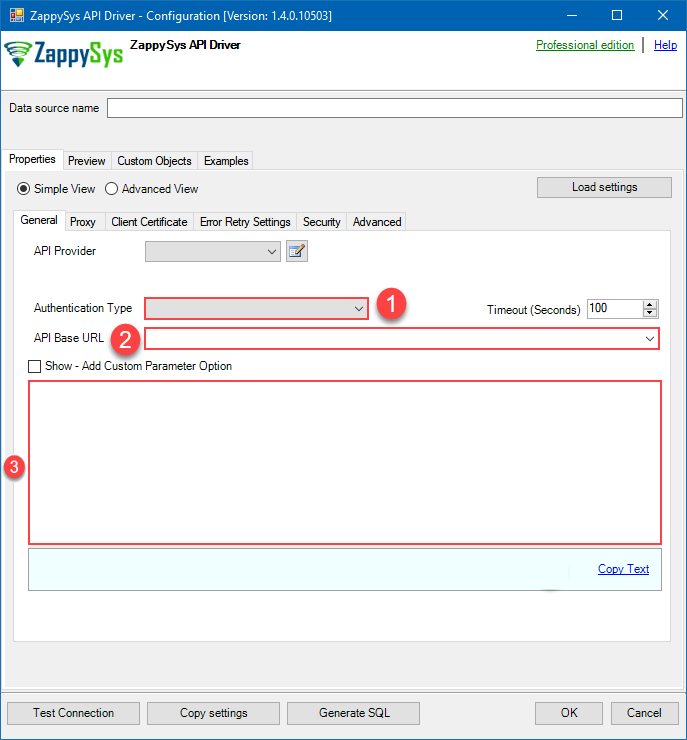
-
Once the data source connection has been configured, it's time to configure the SQL query. Select the Preview tab and then click Query Builder button to configure the SQL query:
 ZappySys API Driver - ServiceNowAllows the reading and writing of incidents, attachments, and more in ServiceNow without coding! The ZappySys ServiceNow API Connector provides easy-to-use, high-performance API access.ServicenowDSN
ZappySys API Driver - ServiceNowAllows the reading and writing of incidents, attachments, and more in ServiceNow without coding! The ZappySys ServiceNow API Connector provides easy-to-use, high-performance API access.ServicenowDSN
-
Start by selecting the Table or Endpoint you are interested in and then configure the parameters. This will generate a query that we will use in SSRS to retrieve data from ServiceNow. Hit OK button to use this query in the next step.
SELECT * FROM incident --Using Primary Key --SELECT * FROM any_table_here WHERE sys_id='109562a3c611227500a7b7ff98cc0dc7' --Primary Key in WHERE clause --Using Filter Expression --SELECT * FROM incident WITH(Query='number=INC0000001') --Equal condition --SELECT * FROM incident WITH(Query='number!=INC0000001') --Not equal condition --SELECT * FROM incident WITH(Query='numberININC0000001,INC0000002,INC0000003') --IN condition --SELECT * FROM incident WITH(Query='number=INC0000001^state=7') --AND condition --SELECT * FROM incident WITH(Query='number=INC0000001^ORnumber=INC0000002') --OR condition --SELECT * FROM incident WITH(Query='numberLIKE0001') --LIKE condition --SELECT * FROM incident WITH(Query='numberSTARTSWITHINC00') --StartWith condition --SELECT * FROM incident WITH(Query='numberENDSWITH0001') --StartWith condition --SELECT * FROM incident WITH(Query='number=INC0000001^state=7^NQORnumber=INC0000002') --AND / OR MIXED using NQ (NewQuery Operator) -- (number=INC0000001 and state=7) OR (number=INC0000002) --more information about filter here https://docs.servicenow.com/bundle/utah-platform-user-interface/page/use/common-ui-elements/reference/r_OpAvailableFiltersQueries.html -- To read all available tables execute this query: -- SELECT * FROM Tables -- Other common tables: ----------------------- -- SELECT * FROM sys_db_object -- SELECT * FROM sys_dictionary -- SELECT * FROM sys_user -- SELECT * FROM sys_user_has_role -- SELECT * FROM sys_user_grmember -- SELECT * FROM task -- SELECT * FROM task_sla -- SELECT * FROM incident -- SELECT * FROM incident_sla -- SELECT * FROM change_request -- SELECT * FROM cmdb_ci_computer -- SELECT * FROM cmdb_ci_outage -- SELECT * FROM cmdb_ci -- SELECT * FROM sn_customerservice_case -- SELECT * FROM kb_knowledge -- SELECT * FROM kb_use -- SELECT * FROM sc_req_item -- SELECT * FROM sc_request -- SELECT * FROM sc_task Some parameters configured in this window will be passed to the ServiceNow API, e.g. filtering parameters. It means that filtering will be done on the server side (instead of the client side), enabling you to get only the meaningful data
Some parameters configured in this window will be passed to the ServiceNow API, e.g. filtering parameters. It means that filtering will be done on the server side (instead of the client side), enabling you to get only the meaningful datamuch faster . -
Now hit Preview Data button to preview the data using the generated SQL query. If you are satisfied with the result, use this query in SSRS:
 ZappySys API Driver - ServiceNowAllows the reading and writing of incidents, attachments, and more in ServiceNow without coding! The ZappySys ServiceNow API Connector provides easy-to-use, high-performance API access.ServicenowDSN
ZappySys API Driver - ServiceNowAllows the reading and writing of incidents, attachments, and more in ServiceNow without coding! The ZappySys ServiceNow API Connector provides easy-to-use, high-performance API access.ServicenowDSNSELECT * FROM incident --Using Primary Key --SELECT * FROM any_table_here WHERE sys_id='109562a3c611227500a7b7ff98cc0dc7' --Primary Key in WHERE clause --Using Filter Expression --SELECT * FROM incident WITH(Query='number=INC0000001') --Equal condition --SELECT * FROM incident WITH(Query='number!=INC0000001') --Not equal condition --SELECT * FROM incident WITH(Query='numberININC0000001,INC0000002,INC0000003') --IN condition --SELECT * FROM incident WITH(Query='number=INC0000001^state=7') --AND condition --SELECT * FROM incident WITH(Query='number=INC0000001^ORnumber=INC0000002') --OR condition --SELECT * FROM incident WITH(Query='numberLIKE0001') --LIKE condition --SELECT * FROM incident WITH(Query='numberSTARTSWITHINC00') --StartWith condition --SELECT * FROM incident WITH(Query='numberENDSWITH0001') --StartWith condition --SELECT * FROM incident WITH(Query='number=INC0000001^state=7^NQORnumber=INC0000002') --AND / OR MIXED using NQ (NewQuery Operator) -- (number=INC0000001 and state=7) OR (number=INC0000002) --more information about filter here https://docs.servicenow.com/bundle/utah-platform-user-interface/page/use/common-ui-elements/reference/r_OpAvailableFiltersQueries.html -- To read all available tables execute this query: -- SELECT * FROM Tables -- Other common tables: ----------------------- -- SELECT * FROM sys_db_object -- SELECT * FROM sys_dictionary -- SELECT * FROM sys_user -- SELECT * FROM sys_user_has_role -- SELECT * FROM sys_user_grmember -- SELECT * FROM task -- SELECT * FROM task_sla -- SELECT * FROM incident -- SELECT * FROM incident_sla -- SELECT * FROM change_request -- SELECT * FROM cmdb_ci_computer -- SELECT * FROM cmdb_ci_outage -- SELECT * FROM cmdb_ci -- SELECT * FROM sn_customerservice_case -- SELECT * FROM kb_knowledge -- SELECT * FROM kb_use -- SELECT * FROM sc_req_item -- SELECT * FROM sc_request -- SELECT * FROM sc_task You can also access data quickly from the tables dropdown by selecting <Select table>.A
You can also access data quickly from the tables dropdown by selecting <Select table>.AWHEREclause,LIMITkeyword will be performed on the client side, meaning that thewhole result set will be retrieved from the ServiceNow API first, and only then the filtering will be applied to the data. If possible, it is recommended to use parameters in Query Builder to filter the data on the server side (in ServiceNow servers). -
Click OK to finish creating the data source.
-
Most Important Step: Now, After creating or modifying a data source in ZappySys Data Gateway, make sure to click the SAVE button to preserve your changes.
Then, RESTART the Data Gateway service to ensure all changes are properly applied.Skipping either step may result in the new settings not taking effect.

Read data in SSRS from ZappySys Data Gateway
- Open Visual Studio and create a new SSRS project
-
Then add a new Shared Data Source (you can create a non-shared data source inside report too):
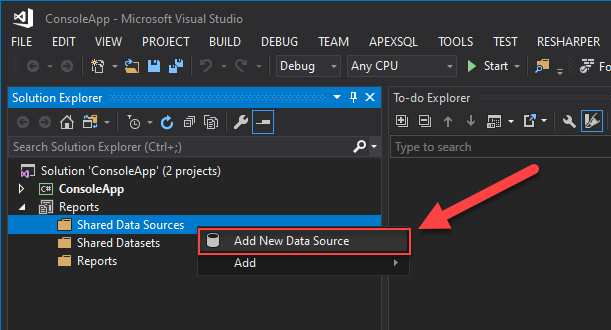
-
Continue with creating the Shared Data Source. Select Microsoft SQL Server as Type and hit Build button to proceed further:
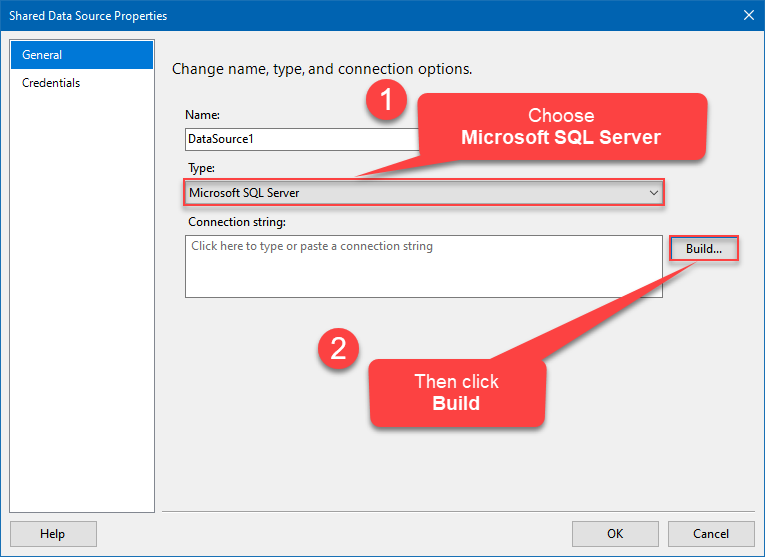
-
Once a window opens, configure it similarly. Configure "ServicenowDSN" as database name. Finally, hit Test Connection and OK:
ServicenowDSN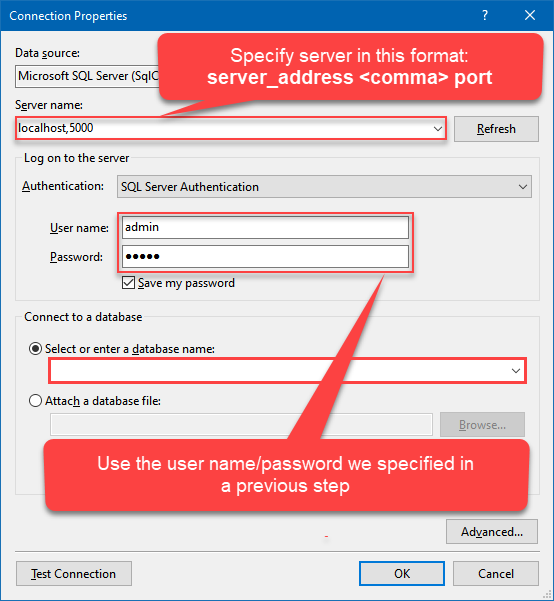
-
Another window opens, and it should look similarly to this one below which ends the creation of a Data Source:
DataSource=localhost,5000;Initial Catalog=ServicenowDSN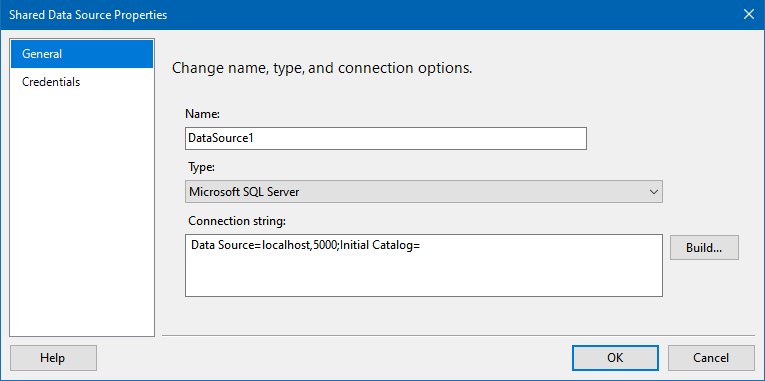
-
Now it's time to create a Dataset. If you don't have a report created, in one of the wizard's steps it will look like this:
SELECT * FROM incident --Using Primary Key --SELECT * FROM any_table_here WHERE sys_id='109562a3c611227500a7b7ff98cc0dc7' --Primary Key in WHERE clause --Using Filter Expression --SELECT * FROM incident WITH(Query='number=INC0000001') --Equal condition --SELECT * FROM incident WITH(Query='number!=INC0000001') --Not equal condition --SELECT * FROM incident WITH(Query='numberININC0000001,INC0000002,INC0000003') --IN condition --SELECT * FROM incident WITH(Query='number=INC0000001^state=7') --AND condition --SELECT * FROM incident WITH(Query='number=INC0000001^ORnumber=INC0000002') --OR condition --SELECT * FROM incident WITH(Query='numberLIKE0001') --LIKE condition --SELECT * FROM incident WITH(Query='numberSTARTSWITHINC00') --StartWith condition --SELECT * FROM incident WITH(Query='numberENDSWITH0001') --StartWith condition --SELECT * FROM incident WITH(Query='number=INC0000001^state=7^NQORnumber=INC0000002') --AND / OR MIXED using NQ (NewQuery Operator) -- (number=INC0000001 and state=7) OR (number=INC0000002) --more information about filter here https://docs.servicenow.com/bundle/utah-platform-user-interface/page/use/common-ui-elements/reference/r_OpAvailableFiltersQueries.html -- To read all available tables execute this query: -- SELECT * FROM Tables -- Other common tables: ----------------------- -- SELECT * FROM sys_db_object -- SELECT * FROM sys_dictionary -- SELECT * FROM sys_user -- SELECT * FROM sys_user_has_role -- SELECT * FROM sys_user_grmember -- SELECT * FROM task -- SELECT * FROM task_sla -- SELECT * FROM incident -- SELECT * FROM incident_sla -- SELECT * FROM change_request -- SELECT * FROM cmdb_ci_computer -- SELECT * FROM cmdb_ci_outage -- SELECT * FROM cmdb_ci -- SELECT * FROM sn_customerservice_case -- SELECT * FROM kb_knowledge -- SELECT * FROM kb_use -- SELECT * FROM sc_req_item -- SELECT * FROM sc_request -- SELECT * FROM sc_task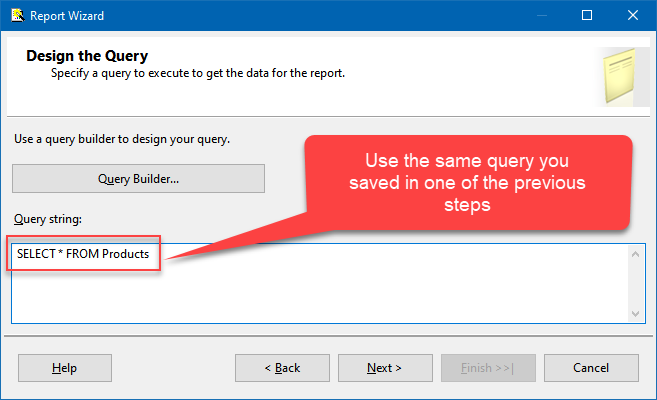
-
Finally, once you complete the report, similar results will show up:
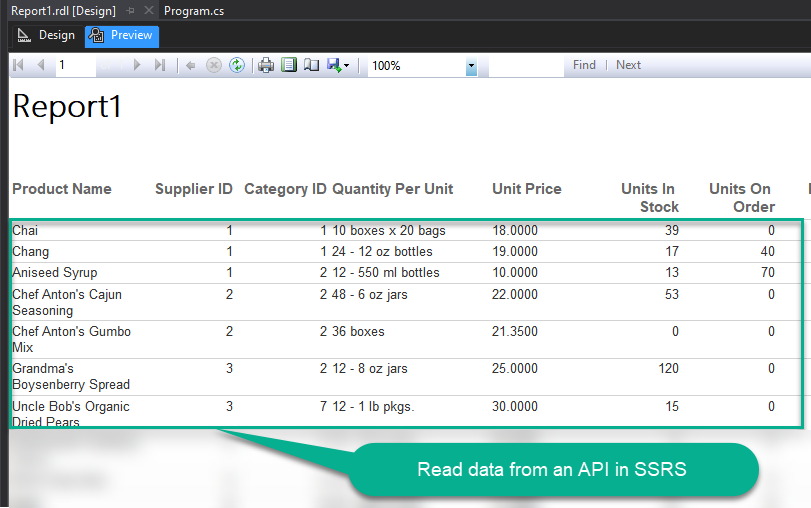
Passing Parameters to SSRS Report / Filter data
If you want to parameterize your report, then refer to this article
Actions supported by ServiceNow Connector
Learn how to perform common ServiceNow actions directly in SSRS with these how-to guides:
- Delete a Table Row
- Delete table row
- Get List Of System Tables Admin Use Sys Db Object
- Get List of Tables
- Get List Of Tables Admin Use Sys Db Object
- Get List Of User Tables Admin Use Sys Db Object
- Get Table Columns
- Get Table Columns Admin Use Sys Dictionary
- Get Table Rows
- Update a Table Row
- Make Generic API Request
- Make Generic API Request (Bulk Write)
Conclusion
In this article we showed you how to connect to ServiceNow in SSRS and integrate data without any coding, saving you time and effort.
We encourage you to download ServiceNow Connector for SSRS and see how easy it is to use it for yourself or your team.
If you have any questions, feel free to contact ZappySys support team. You can also open a live chat immediately by clicking on the chat icon below.
Download ServiceNow Connector for SSRS Documentation











































































